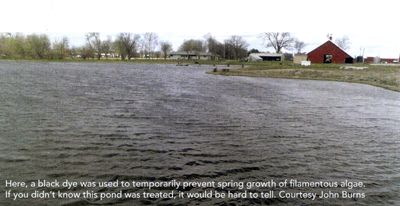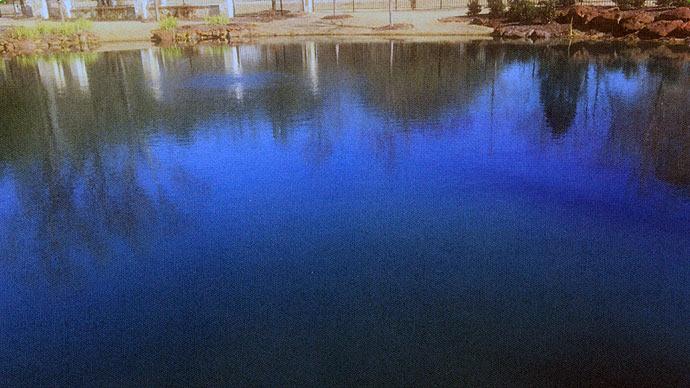
On the Ask the Boss discussion forum on the www.pondboss.com website, a long-standing discussion started in 2016 was recently revived. The original question was centered around finding information about how pond dye impacts pond ecology.
I love the forum because of the free exchange of ideas and opinions between passionate and knowledgeable people. There seemed to be some conflicting information and opinions in this thread. But after digesting all of it, the logic came into focus to help people make the best decisions about whether or not to use pond dyes and when to do it, based on individual goals.
There were plenty of opinions, with several that looked at reverse logic that also makes good sense.
The dominating fact focusing the discussion was understanding pond dye's job is to reduce the sun's penetration of ultraviolet rays into the water. Therefore, the discussion centered around the impact of that fact.
Pond pros explained that primary productivity is virtually eliminated from ponds dyed during warm months. When dye reduces UV rays, the primary productivity of phytoplankton is seriously reduced. Without plankton, the base of the food chain is interrupted. Remember that each trophic level of the food chain offers a ten-to-one conversion to the next level. In other words, ten pounds of nutrients grow a pound of phytoplankton. Ten pounds of phytoplankton feed a pound of zooplankton. Ten pounds of zooplankton produces a pound of tiny insects and baby fish...and so on, up the food chain. Pond dye stops that productivity at the bottom, impacting the base.
Without that base, which can literally be tons of food, even in a small pond, expect fewer insects, much lower survival rates of newly hatched baby fish, and much less food for the larger fish, all the way up to the top of the pond's food chain.
That's if UV rays are eliminated during months of high plankton production. What about using it during cool months, before spring, to help prevent unwanted algae blooms or to postpone the eruption of noxious rooted plants? That is a common reason to use the stuff. Put that in the pro column. Without sunlight, that scummy, ugly filamentous algae struggles to gain a foothold. Put that on the pro side of the argument. Plankton isn't prolific during cool months, but filamentous algae can get a jumpstart before plankton wakes up. Using dye during those months to push back the start date of algae is one of the pros. Using it during warm months is one of the cons. Or, is it?
A pondmeister in Indiana said he uses dye all year long because he heavily feeds his hybrid sunfish and doesn't want them to reproduce. Since hybrid sunfish reproduce minimally as it is, he has a reasonable goal. He also doesn't want to deal with a heavy plankton bloom nor want rooted vegetation to overtake his shallow areas. Pond dye, in his circumstance, allows him to circumvent nature's classic offerings. He beats what nature would do to beat his goals. That shifts dye into the pro column for his goals. Since he's in the northern part of the nation, keeping primary productivity and aquatic plant growth to a minimum reduces his risk of winterkill. He is another pro because of his goals.
A key point here. Pond dye has no vehicle to eliminate plants. It doesn't eradicate anything except the sun's rays penetrating the water. That means it is a preventative, not a curative.
Bill Cody made several cogent points. One big one is that different dye colors have different impacts because they filter different light wavelengths, affecting photosynthesis. So, dye color can impact the ecology of your pond. Good to know, but what color do we choose? Of course, you can pick blue, which is the typical color. But black is a popular color as well. There are several shades of blue, some companies add yellow to create green, but each one serves a similar purpose.
The discussion took another direction when one poster suggested that pond dye helps "clear up a pond." At least one dye makes that claim. But Cody expounded, "The best way a pond dye can clear a pond is to interrupt the bloom, the plankton dies, and sinks, which increases water clarity. There is no evidence that dye adjusts suspended clay particles or otherwise impacts the chemistry of your water.
Another critical point about dye is its lifespan in the water. Over time, it dilutes, flows away, or fades out. So look at it as temporary.
The take-home points were made clear. Dye prevents the sun's UV rays from going very deeply into the water, preventing plants from growing. It prevents plankton, which has an impact on primary productivity. That can be seen either as a pro or a con.
The bottom line is to understand this valuable pond management tool and use it appropriately. As with every tool in your pond management tool kit, consider the consequences before choosing to use it.
No one wants their pond to look like the Ty-D-Bowl man has been swimming in the pond...or do you?
Reprinted with permission from Pond Boss Magazine



